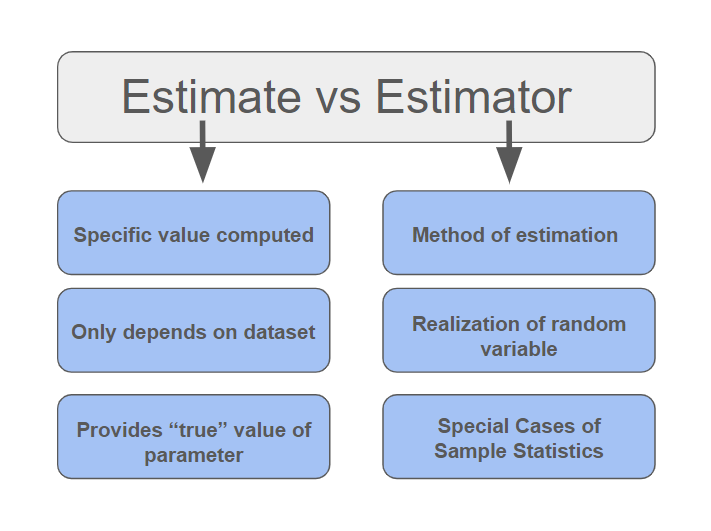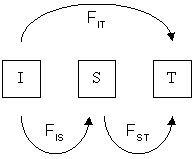|
Population Structure (genetics)
Population structure (also called genetic structure and population stratification) is the presence of a systematic difference in allele frequencies between subpopulations. In a randomly mating (or ''panmictic'') population, allele frequencies are expected to be roughly similar between groups. However, mating tends to be non-random to some degree, causing structure to arise. For example, a barrier like a river can separate two groups of the same species and make it difficult for potential mates to cross; if a mutation occurs, over many generations it can spread and become common in one subpopulation while being completely absent in the other. Genetic variants do not necessarily cause observable changes in organisms, but can be correlated by coincidence because of population structure—a variant that is common in a population that has a high rate of disease may erroneously be thought to cause the disease. For this reason, population structure is a common confounding variable in med ... [...More Info...] [...Related Items...] OR: [Wikipedia] [Google] [Baidu] |
Allele
An allele is a variant of the sequence of nucleotides at a particular location, or Locus (genetics), locus, on a DNA molecule. Alleles can differ at a single position through Single-nucleotide polymorphism, single nucleotide polymorphisms (SNP), but they can also have insertions and deletions of up to several thousand base pairs. Most alleles observed result in little or no change in the function or amount of the gene product(s) they code or regulate for. However, sometimes different alleles can result in different observable phenotypic traits, such as different pigmentation. A notable example of this is Gregor Mendel's discovery that the white and purple flower colors in pea plants were the result of a single gene with two alleles. Nearly all multicellular organisms have two sets of chromosomes at some point in their biological life cycle; that is, they are diploid. For a given locus, if the two chromosomes contain the same allele, they, and the organism, are homozygous with re ... [...More Info...] [...Related Items...] OR: [Wikipedia] [Google] [Baidu] |
Panmixia
Panmixia (or panmixis) means uniform random fertilization, which means individuals do not select a mate based on physical traits. A panmictic population is one where all potential parents may contribute equally to the gamete pool, and that these gametes are uniformly distributed within the gamete population (gamodeme). This assumes that there are no hybridising restrictions within the parental population: neither genetics, cytogenetics nor behavioural; and neither spatial nor temporal (see also Quantitative genetics for further discussion). True panmixia is rarely, if ever, observed in natural populations. It is a theoretical model used as a null hypothesis in population genetics. It serves as a point of comparison to understand how deviations from random mating affect allele and genotype frequencieTherefore, all gamete recombination (fertilization) is uniformly possible. Both the Wahlund effect and the Hardy Weinberg equilibrium assume that the overall population is panmictic. In ... [...More Info...] [...Related Items...] OR: [Wikipedia] [Google] [Baidu] |
Markov Chain Monte Carlo
In statistics, Markov chain Monte Carlo (MCMC) is a class of algorithms used to draw samples from a probability distribution. Given a probability distribution, one can construct a Markov chain whose elements' distribution approximates it – that is, the Markov chain's Discrete-time Markov chain#Stationary distributions, equilibrium distribution matches the target distribution. The more steps that are included, the more closely the distribution of the sample matches the actual desired distribution. Markov chain Monte Carlo methods are used to study probability distributions that are too complex or too highly N-dimensional space, dimensional to study with analytic techniques alone. Various algorithms exist for constructing such Markov chains, including the Metropolis–Hastings algorithm. General explanation Markov chain Monte Carlo methods create samples from a continuous random variable, with probability density proportional to a known function. These samples can be used to e ... [...More Info...] [...Related Items...] OR: [Wikipedia] [Google] [Baidu] |
Jonathan K
Jonathan may refer to: *Jonathan (name), a masculine given name Media * ''Jonathan'' (1970 film), a German film directed by Hans W. Geißendörfer * ''Jonathan'' (2016 film), a German film directed by Piotr J. Lewandowski * ''Jonathan'' (2018 film), an American film directed by Bill Oliver * ''Jonathan'' (Buffy comic), a 2001 comic book based on the ''Buffy the Vampire Slayer'' television series *Jonathan (TV show), a Welsh-language television show hosted by ex-rugby player Jonathan Davies People and biblical figures Bible *Jonathan (1 Samuel), son of King Saul of Israel and friend of David, in the Books of Samuel *Jonathan (Judges), in the Book of Judges *Jonathan (son of Abiathar), in 2 Samuel and 1 Kings Judaism *Jonathan Apphus, fifth son of Mattathias and leader of the Hasmonean dynasty of Judea from 161 to 143 BCE * Rabbi Jonathan, 2nd century *Jonathan (High Priest), a High Priest of Israel in the 1st century Footballers * Jonathan (footballer, born 1991) * Jonathan ... [...More Info...] [...Related Items...] OR: [Wikipedia] [Google] [Baidu] |
Estimator
In statistics, an estimator is a rule for calculating an estimate of a given quantity based on Sample (statistics), observed data: thus the rule (the estimator), the quantity of interest (the estimand) and its result (the estimate) are distinguished. For example, the sample mean is a commonly used estimator of the population mean. There are point estimator, point and interval estimators. The point estimators yield single-valued results. This is in contrast to an interval estimator, where the result would be a range of plausible values. "Single value" does not necessarily mean "single number", but includes vector valued or function valued estimators. ''Estimation theory'' is concerned with the properties of estimators; that is, with defining properties that can be used to compare different estimators (different rules for creating estimates) for the same quantity, based on the same data. Such properties can be used to determine the best rules to use under given circumstances. Howeve ... [...More Info...] [...Related Items...] OR: [Wikipedia] [Google] [Baidu] |
Genetic Admixture
Genetic admixture occurs when previously isolated populations interbreed resulting in a population that is descended from multiple sources. It can occur between species, such as with hybrids, or within species, such as when geographically distant individuals migrate to new regions. It results in gene pool that is a mix of the source populations. Examples Climatic cycles facilitate genetic admixture in cold periods and genetic diversification in warm periods. Natural flooding can cause genetic admixture within populations of migrating fish species. Genetic admixture may have an important role for the success of populations that colonise a new area and interbreed with individuals of native populations. Mapping Admixture mapping is a method of gene mapping that uses a population of mixed ancestry (an admixed population) to find the genetic loci that contribute to differences in diseases or other phenotypes found between the different ancestral populations. The method is best app ... [...More Info...] [...Related Items...] OR: [Wikipedia] [Google] [Baidu] |
Metric (mathematics)
In mathematics, a metric space is a set together with a notion of ''distance'' between its elements, usually called points. The distance is measured by a function called a metric or distance function. Metric spaces are a general setting for studying many of the concepts of mathematical analysis and geometry. The most familiar example of a metric space is 3-dimensional Euclidean space with its usual notion of distance. Other well-known examples are a sphere equipped with the angular distance and the hyperbolic plane. A metric may correspond to a metaphorical, rather than physical, notion of distance: for example, the set of 100-character Unicode strings can be equipped with the Hamming distance, which measures the number of characters that need to be changed to get from one string to another. Since they are very general, metric spaces are a tool used in many different branches of mathematics. Many types of mathematical objects have a natural notion of distance and th ... [...More Info...] [...Related Items...] OR: [Wikipedia] [Google] [Baidu] |
Triangle Inequality
In mathematics, the triangle inequality states that for any triangle, the sum of the lengths of any two sides must be greater than or equal to the length of the remaining side. This statement permits the inclusion of Degeneracy (mathematics)#Triangle, degenerate triangles, but some authors, especially those writing about elementary geometry, will exclude this possibility, thus leaving out the possibility of equality. If , , and are the lengths of the sides of a triangle then the triangle inequality states that :c \leq a + b , with equality only in the degenerate case of a triangle with zero area. In Euclidean geometry and some other geometries, the triangle inequality is a theorem about vectors and vector lengths (Norm (mathematics), norms): :\, \mathbf u + \mathbf v\, \leq \, \mathbf u\, + \, \mathbf v\, , where the length of the third side has been replaced by the length of the vector sum . When and are real numbers, they can be viewed as vectors in \R^1, and the triang ... [...More Info...] [...Related Items...] OR: [Wikipedia] [Google] [Baidu] |
Genetic Distance
Genetic distance is a measure of the genetics, genetic divergence between species or between population#Genetics, populations within a species, whether the distance measures time from common ancestor or degree of differentiation. Populations with many similar alleles have small genetic distances. This indicates that they are closely related and have a recent common ancestor. Genetic distance is useful for reconstructing the history of populations, such as the multiple human expansions Out of Africa theory, out of Africa. It is also used for understanding the origin of biodiversity. For example, the genetic distances between different breeds of domesticated animals are often investigated in order to determine which breeds should be protected to maintain genetic diversity. Biological foundation Life on earth began from very simple Unicellular organism, unicellular organisms evolving into most complex Multicellular organism, multicellular organisms through the course of over three b ... [...More Info...] [...Related Items...] OR: [Wikipedia] [Google] [Baidu] |
F-statistics
In population genetics, ''F''-statistics (also known as fixation indices) describe the statistically expected level of heterozygosity in a population; more specifically the expected degree of (usually) a reduction in heterozygosity when compared to Hardy–Weinberg expectation. ''F''-statistics can also be thought of as a measure of the correlation between genes drawn at different levels of a (hierarchically) subdivided population. This correlation is influenced by several evolution Evolution is the change in the heritable Phenotypic trait, characteristics of biological populations over successive generations. It occurs when evolutionary processes such as natural selection and genetic drift act on genetic variation, re ...ary processes, such as genetic drift, founder effect, population bottleneck, bottleneck, genetic hitchhiking, meiotic drive, mutation, gene flow, inbreeding, natural selection, or the Wahlund effect, but it was originally designed to measure the amount ... [...More Info...] [...Related Items...] OR: [Wikipedia] [Google] [Baidu] |
Recent Common Ancestor
A most recent common ancestor (MRCA), also known as a last common ancestor (LCA), is the most recent individual from which all organisms of a set are inferred to have descended. The most recent common ancestor of a higher taxon is generally assumed to have been a species. The term is also used in reference to the ancestry of groups of genes (haplotypes) rather than organisms. The ancestry of a set of individuals can sometimes be determined by referring to an established pedigree, although this may refer only to patrilineal or matrilineal lines for sexually-reproducing organisms with two parents, four grandparents, etc. However, in general, it is impossible to identify the exact MRCA of a large set of individuals, but an estimate of the time at which the MRCA lived can often be given. Such ''time to most recent common ancestor'' (''TMRCA'') estimates can be given based on DNA test results and established mutation rates as practiced in genetic genealogy, or by reference to a non-g ... [...More Info...] [...Related Items...] OR: [Wikipedia] [Google] [Baidu] |
Inbreeding
Inbreeding is the production of offspring from the mating or breeding of individuals or organisms that are closely genetic distance, related genetically. By analogy, the term is used in human reproduction, but more commonly refers to the genetic disorders and other consequences that may arise from expression of wikt:deleterious, deleterious dominance (genetics), recessive traits resulting from incestuous sexual relationships and consanguinity. Animals avoid inbreeding only rarely. Inbreeding results in homozygous, homozygosity which can increase the chances of offspring being affected by recessive phenotypic trait, traits. In extreme cases, this usually leads to at least temporarily decreased Fitness (biology), biological fitness of a population (called inbreeding depression), which is its ability to survive and reproduce. An individual who inherits such deleterious traits is colloquially referred to as ''inbred''. The avoidance of expression of such deleterious recessive allel ... [...More Info...] [...Related Items...] OR: [Wikipedia] [Google] [Baidu] |






